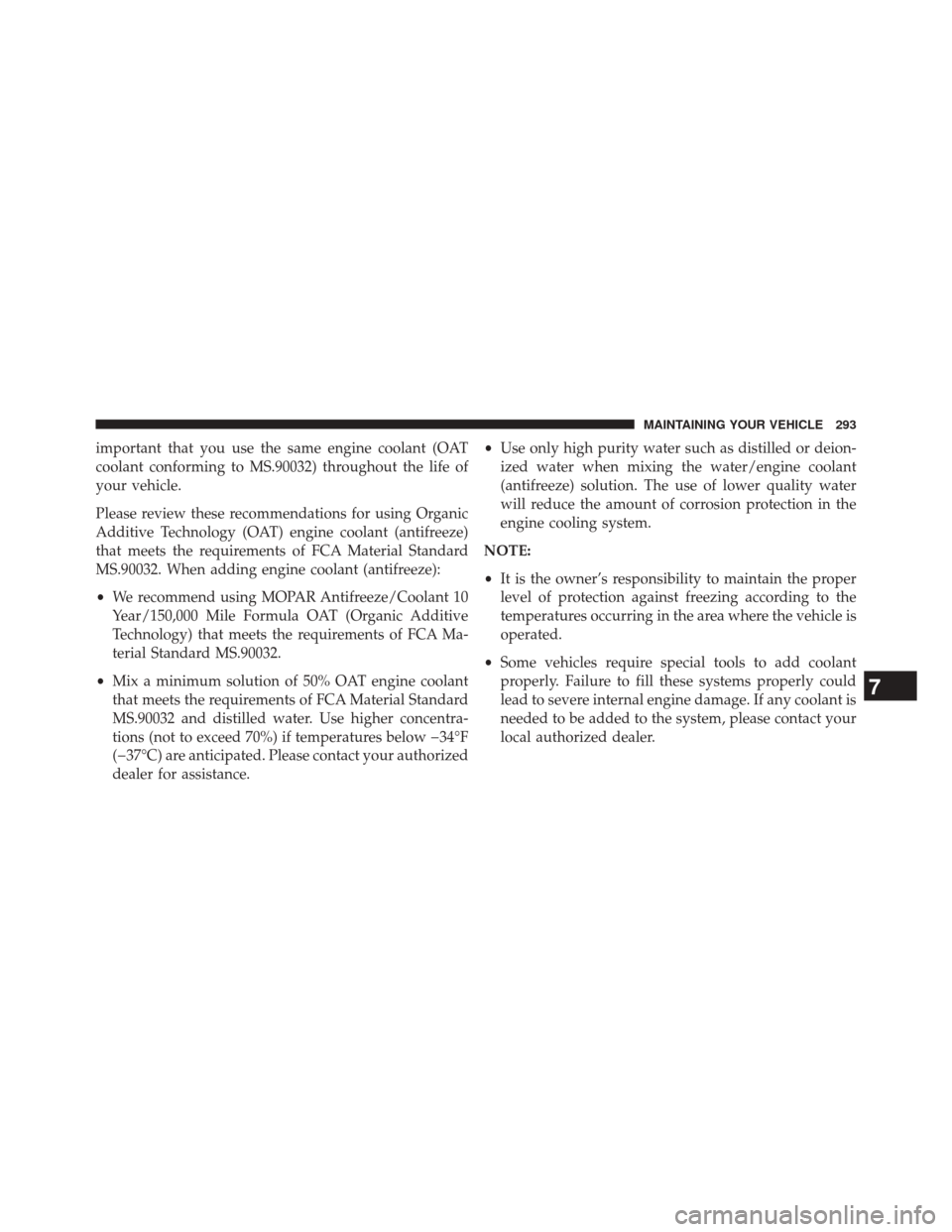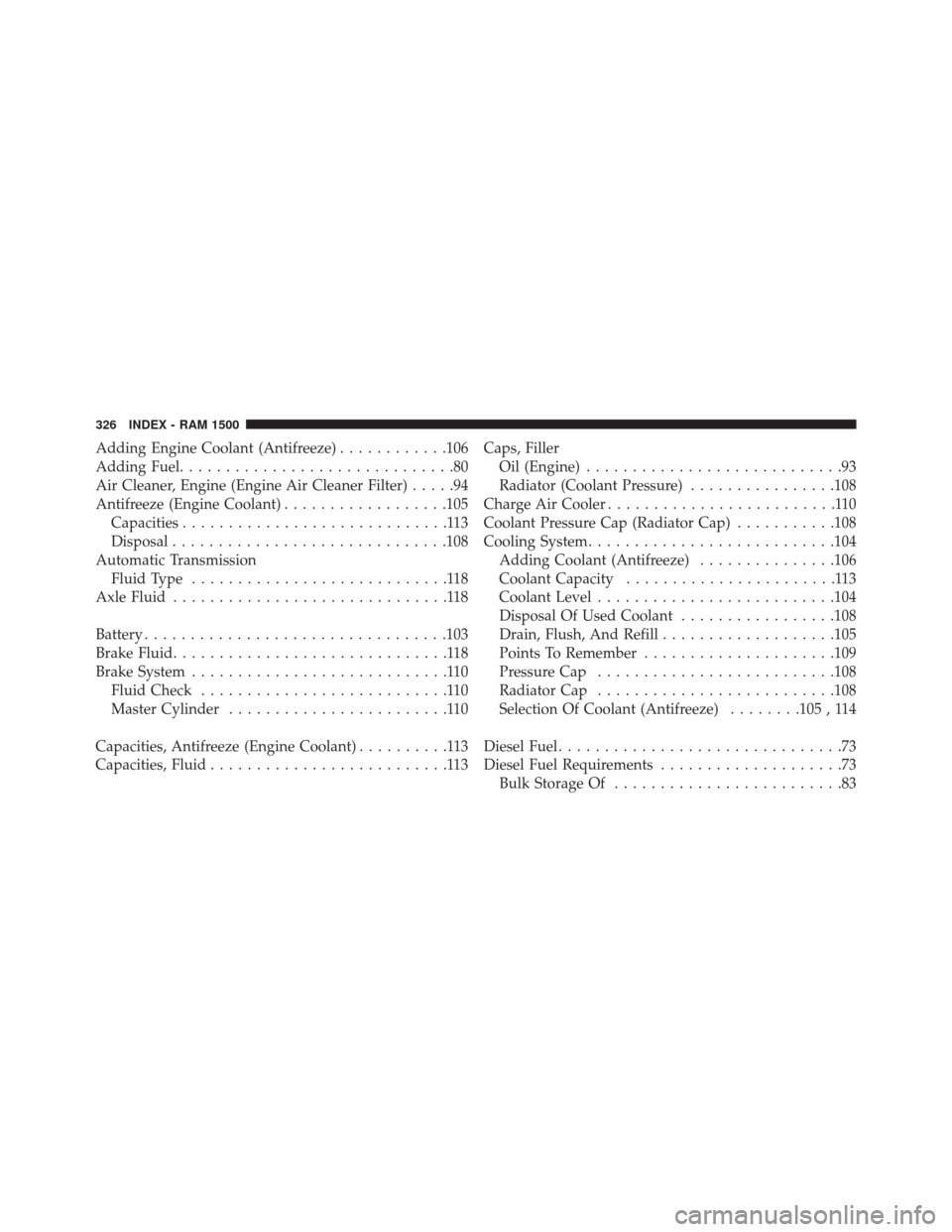2016 Ram 3500 coolant level
[x] Cancel search: coolant levelPage 166 of 338

•Engine Power Reduced Up To 30 Sec (Seconds)
During Warmup — This message will display during
start up when the ambient temperature is between
-10° F (-23° C) and -25 F (-32° C).
• Engine Power Reduced Up To 2 Min (Minutes)
During Warmup — This message will display during
start up when the ambient temperature is -25° F
(-32°C) and below.
• Coolant Low — This telltale will turn on to indicate
the vehicle coolant level is low. See “Adding Coolant”
under the section “Maintaining Your Vehicle” for more
information.
Diesel Particulate Filter (DPF) Messages
The Cummins diesel engine meets all diesel emissions
standards, resulting in one of the lowest emitting diesel
engines ever produced. To achieve these emissions stan-
dards, your vehicle is equipped with a state-of-the-art engine and exhaust system. These systems are seamlessly
integrated into your vehicle and managed by the Pow-
ertrain Control Module (PCM). The PCM manages en-
gine combustion to allow the exhaust system’s catalyst to
trap and burn Particulate Matter (PM) pollutants, with no
input or interaction on your part.
WARNING!
A hot exhaust system can start a fire if you park over
materials that can burn. Such materials might be
grass or leaves coming into contact with your exhaust
system. Do not park or operate your vehicle in areas
where your exhaust system can contact anything that
can burn.
164 UNDERSTANDING YOUR INSTRUMENT PANEL
Page 178 of 338

NOTE:The “Wait To Start” telltale may not illuminate if
the intake manifold temperature is warm enough.
Low Diesel Exhaust Fluid Light
This telltale will turn on to indicate the Diesel
Exhaust Fluid (DEF) is low.
Cold Ambient Derate Mode Messages
The vehicle will display messages when a derate (engine
power reduction) is activated to protect the turbocharger
during engine start up in cold ambient temperatures.
•Engine Power Reduced During Warmup — This
message will display during start up when the ambi-
ent temperature is between 10° F (-12° C) and -10° F
(-23° C). •
Engine Power Reduced Up To 30 Sec (Seconds)
During Warmup — This message will display during
start up when the ambient temperature is between
-10° F (-23° C) and -25 F (-32° C).
• Engine Power Reduced Up To 2 Min (Minutes)
During Warmup — This message will display during
start up when the ambient temperature is -25° F
(-32° C) and below.
• Coolant Low — This telltale will turn on to indicate
the vehicle coolant level is low. See “Adding Coolant”
under the section “Maintaining Your Vehicle” for more
information.
Diesel Particulate Filter (DPF) Messages
The Cummins diesel engine meets all diesel emissions
standards, resulting in one of the lowest emitting diesel
engines ever produced. To achieve these emissions stan-
dards, your vehicle is equipped with a state-of-the-art
176 UNDERSTANDING YOUR INSTRUMENT PANEL
Page 295 of 338

important that you use the same engine coolant (OAT
coolant conforming to MS.90032) throughout the life of
your vehicle.
Please review these recommendations for using Organic
Additive Technology (OAT) engine coolant (antifreeze)
that meets the requirements of FCA Material Standard
MS.90032. When adding engine coolant (antifreeze):
•We recommend using MOPAR Antifreeze/Coolant 10
Year/150,000 Mile Formula OAT (Organic Additive
Technology) that meets the requirements of FCA Ma-
terial Standard MS.90032.
• Mix a minimum solution of 50% OAT engine coolant
that meets the requirements of FCA Material Standard
MS.90032 and distilled water. Use higher concentra-
tions (not to exceed 70%) if temperatures below �34°F
(�37°C) are anticipated. Please contact your authorized
dealer for assistance. •
Use only high purity water such as distilled or deion-
ized water when mixing the water/engine coolant
(antifreeze) solution. The use of lower quality water
will reduce the amount of corrosion protection in the
engine cooling system.
NOTE:
• It is the owner’s responsibility to maintain the proper
level of protection against freezing according to the
temperatures occurring in the area where the vehicle is
operated.
• Some vehicles require special tools to add coolant
properly. Failure to fill these systems properly could
lead to severe internal engine damage. If any coolant is
needed to be added to the system, please contact your
local authorized dealer.
7
MAINTAINING YOUR VEHICLE 293
Page 298 of 338

•Do not change the thermostat for Summer or Winter
operation. If replacement is ever necessary, install
ONLY the correct type thermostat. Other designs may
result in unsatisfactory engine coolant (antifreeze)
performance, poor gas mileage, and increased emis-
sions.
Charge Air Cooler — Inter-Cooler
The charge air cooler is positioned below the radiator and
the air conditioner condenser. Air enters the engine
through the air cleaner and passes through the turbo-
charger, where it is pressurized. This pressurized air
rapidly reaches high temperature. The air is then directed
through a hose to the charge air cooler and through
another hose to the intake manifold of the engine. The air
entering the engine has been cooled by about 50° to 100°F
(10° to 38°C). This cooling process enables more efficient
burning of fuel resulting in fewer emissions. To guarantee optimum performance of the system, keep
the surfaces of the charge air cooler, condenser and
radiator clean and free of debris. Periodically check the
hoses leading to and from the charge air cooler for cracks
or loose clamps resulting in loss of pressure and reduced
engine performance.
Brake System
Brake Master Cylinder — Brake Fluid Level Check
The fluid level of the master cylinder should be checked
when performing under the hood service, or immedi-
ately if the “Brake System Warning Light” indicates
system failure.
The brake master cylinder has a translucent plastic
reservoir. On the outboard side of the reservoir, there is a
“MAX” mark and a “MIN” mark. The fluid level must be
kept within these two marks. Do not add fluid above the
full mark because leakage may occur at the cap.
296 MAINTAINING YOUR VEHICLE
Page 316 of 338

MAINTENANCE SCHEDULE — DIESEL ENGINE
CAUTION!
Failure to perform the required maintenance items
may result in damage to the vehicle.
At Each Stop For Fuel
Check the engine oil level at least 30 minutes after a fully
warmed engine is shut off. Checking the oil level while
the vehicle is on level ground will improve the accuracy
of the oil level reading. Add oil only when the level is at
or below the ADD or MIN mark.
Once A Month
• Inspect the batteries, and clean and tighten the termi-
nals as required. •
Check the fluid levels of the coolant reservoir, brake
master cylinder, and automatic transmission (if
equipped), and add as needed.
At Each Oil Change
• Change the engine oil filter.
• Inspect the exhaust system.
• Inspect engine air filter.
• Check the coolant level, hoses, and clamps.
• Lubricate outer tie rod ends.
Inspection and service should also be performed anytime
a malfunction is observed or suspected. Retain all re-
ceipts.
Oil Change Indicator System — Cummins Diesel
Your vehicle is equipped with an engine oil change
indicator system. This system will alert you when it is
time to change your engine oil by displaying the words
314 MAINTENANCE SCHEDULE
Page 324 of 338

Mileage or time passed
(whichever comes first):
7,500
15,000
22,500
30,000
37,500
45,000
52,500
60,000
67,500
75,000
82,500
90,000
97,500
105,000 112,500
120,000
127,500
135,000
142,500
150,000
Or Months: 6 12 18 24 30 36 42 48 54 60 66 72 78 84 90 96 102 108 114 120
Or Kilometers:
12,000
24,000
36,000
48,000
60,000
72,000
84,000
96,000
108,000
120,000
132,000
144,000
156,000
168,000
180,000
192,000
204,000
216,000
228,000
240,000
Flush and replace power steering
fluid. X
Flush and replace engine
coolant. *** X
Adjust valve lash clearance. X
Inspection and service should also be performed anytime
a malfunction is observed or suspected. Retain all re-
ceipts.
* Inspect the front and rear axle surfaces every 20,000
miles (32,000 km). If gear oil leakage is suspected, checkthe fluid level. If using your vehicle for police, taxi, fleet,
off-road or frequent trailer towing change the axle fluid
every 20,000 miles (32,000 km).
** Under no circumstances should oil change intervals
exceed 15,000 miles (24 000 km) or six months or 500
Hours, whichever comes first.
322 MAINTENANCE SCHEDULE
Page 328 of 338

Adding Engine Coolant (Antifreeze)............106
Adding Fuel ..............................80
Air Cleaner, Engine (Engine Air Cleaner Filter) .....94
Antifreeze (Engine Coolant) ..................105
Capacities .............................113
Disposal ............................. .108
Automatic Transmission Fluid Type ............................118
Axle Fluid ..............................118
Battery ................................ .103
Brake Fluid ..............................118
Brake System ............................110
Fluid Check ...........................110
Master Cylinder ........................110
Capacities, Antifreeze (Engine Coolant) ..........113
Capacities, Fluid ..........................113 Caps, Filler
Oil (Engine) ............................93
Radiator (Coolant Pressure) ................108
Charge Air Cooler .........................110
Coolant Pressure Cap (Radiator Cap) ...........108
Cooling System .......................... .104
Adding Coolant (Antifreeze) ...............106
Coolant Capacity .......................113
Coolant Level ......................... .104
Disposal Of Used Coolant .................108
Drain, Flush, And Refill ...................105
Points To Remember .....................109
Pressure Cap ......................... .108
Radiator Cap ......................... .108
Selection Of Coolant (Antifreeze) ........105 , 114
Diesel Fuel ...............................73
Diesel Fuel Requirements ....................73
Bulk Storage Of .........................83
326 INDEX - RAM 1500
Page 329 of 338

Diesel Fuel System, Re-Priming...............101
Disposal Antifreeze (Engine Coolant) ................108
Draining Fuel/Water Separator Filter ............97
Electronic Vehicle Information Center (EVIC) ......25
Engine ..................................90
Air Cleaner ............................94
Block Heater ........................66,73
Break-In Recommendations .................13
Compartment ...........................90
Coolant (Antifreeze) .....................114
Identification ...........................90
Idling ................................70
Oil...............................92,114
Oil Filler Cap ...........................93
Filters Air Cleaner ............................94
Engine Fuel ............................97 Engine Oil
.........................94,114
Engine Oil Disposal ......................94
Fluid Capacities ..........................113
Fluid Level Checks Brake ................................110
Fluid, Brake .............................118
Fluids, Lubricants And Genuine Parts ...........114
Fuel ...................................73
Adding ...............................80
Diesel ............................73,114
Filter .................................97
Requirements ...........................73
Specifications ...........................74
Tank Capacity ..........................113
Fueling .................................80
Gauges Voltmeter ..............................68
8
INDEX - RAM 1500 327